Taiwanese Suppliers Are Key Parts at 2010 Automechanika Frankfurt
2011/02/23 | By Quincy LiangThe best place to see first-hand the forte wielded by Taiwanese after-market auto-parts makers is the 2010 Automechanika Frankfurt, the world's largest bi-annual auto-parts fair focusing on the aftermarket. Some 4,486 exhibitors from 76 countries were spread over 305,000 square meters at the venue, including about 500 companies from Taiwan this time.
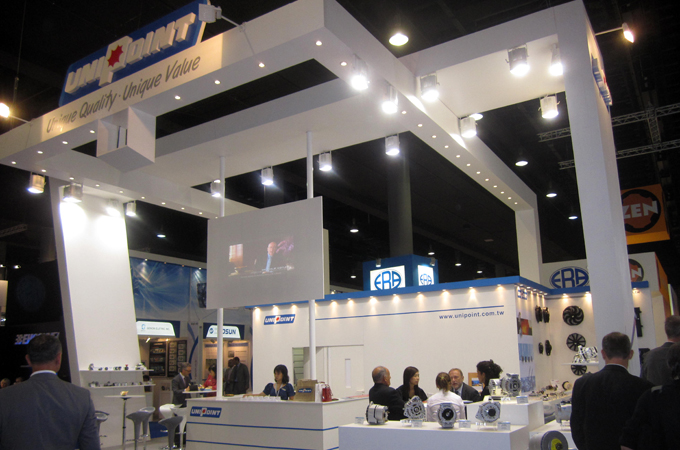
Taiwan is well-known for its strong global competitiveness in the AM auto-parts business. In addition to offering comprehensive lines and small-batch, large-variety order processing that are most suitable to the AM parts business, Taiwanese auto-parts makers also are backed by the world-class electronics and information and communication technology (ICT), semiconductor, microelectromechanical systems (MEMS) industries in Taiwan.
Notable Exhibitors
Collision Parts
Auto Parts Industrial Ltd. (API), a major supplier of AM collision replacement parts, acquired facilities in the past years to set up in-house production of sheet-metal parts, cooling fans, window regulators etc. Four years ago, the firm acquired Procom, a maker of composite materials, glass fiber, and engineering plastic.
In 2008, API installed various manufacturing equipment at Procom to begin producing plastic parts, including plastic bumpers, grills, radiator supports etc.
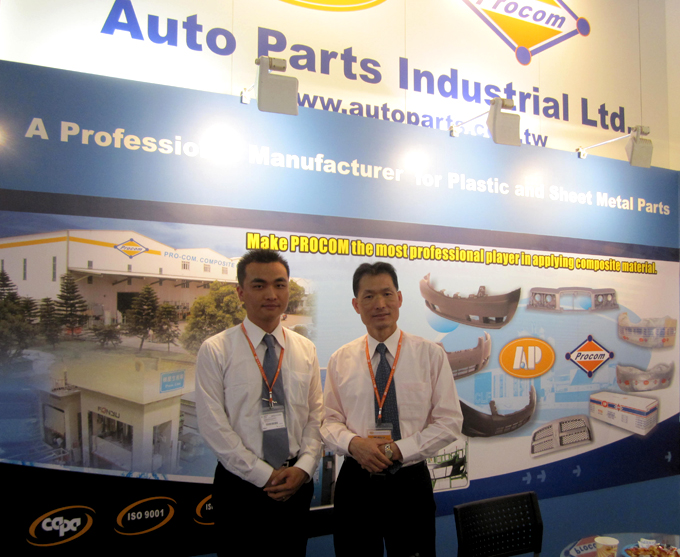
Miller Lai, the manager of Sales Dept. II, points out that the company now focuses on the development of more plastic parts, adding that Procom targets to develop 200 molds for bumpers and grills for popular makes and models.
To meet ever-increasing demand, Lai adds, API has also expanded its logistics capacity to about 400 containers per month, so API's annual revenue is now between NT$4 billion to NT$5 billion (US$12.9 million to NT$16.1 million). "Unlike other big AM parts suppliers who focus mainly on selling self-produced items, our company concentrate on meeting customers' demand to be more service-oriented. We can supply items without having our buyers go to other makers,” says Lai.
Expressing optimism about the company's sales worldwide, Lai says that this year API's sales in New Zealand, Austria, and South Africa have increased remarkably, and that South Africa is expected to be an important market driven by steady economic growth for over 10 years. About 40% of API's products are sold to North America and 20% to Europe.
Taiwan's bigger high-quality AM collision parts suppliers will grow even bigger for global customers want to deal directly with one or few suppliers who can provide many different parts in low volumes to make sourcing easy, explains Lai. “API is very good at this game for we offer high-quality products at very reasonable prices, which is achieved by effective cost-control, technical capability, efficient personnel,” adds Lai.
CAN-bus Meters
Lyssen Enterprise Co., Ltd. (Progauges brand), a leading auto-gauge maker in Taiwan and one of the very few able to fully build Controller Area Network (CAN)-Bus meter, showcased its latest "information center cluster" at the show. The high-end CAN-Bus gauge cluster displays visibly and audibly all the diagnostic messages via sensors in a vehicle, with the gauge able to be customized.
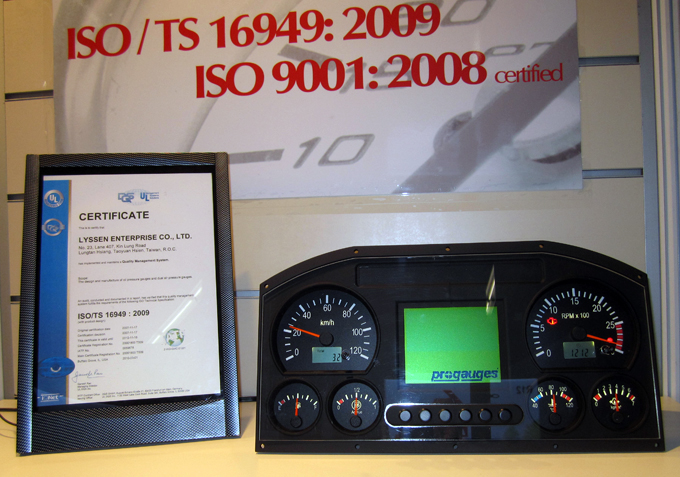
Susan Lee, director of Lyssen's overseas marketing department, claims that her company has been developing and selling ever more high-tech products for leading vehicle or agricultural machinery brands.
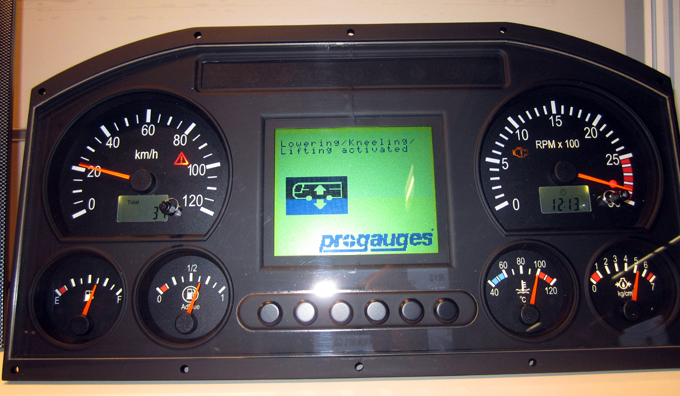
"With strong R&D capability, we have been developing really innovative products, including a CAN-Bus center clusters with sophisticated algorithms for agricultural tractors that automatically measure land area and count the needed number of seeds/fertilizers.
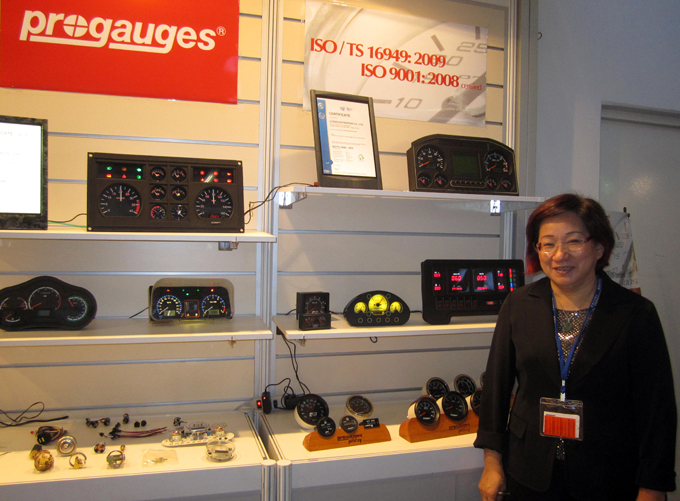
Since the 1980s, Lee says, installing ECUs (electronic control unit) in vehicles has enabled the CAN-Bus to communicate with each other to enhance driving stability, safety, comfort and fuel economy. More than 40 communication protocols for CAN-Bus have been developed so far and are classified by the Society of Automotive Engineers (SAE), with such sub-systems adopted for power, chassis, air condition, body, and diagnostic systems etc.
Lyssen can fully develop, produce in-house CAN-Bus meters in mainly three types: master-slave meters, multi-channel meters, and information center meters, says Lee.
OBD II Multi-functional Gauge
Trisco Technology Corp. showed its multi-functional gauge that utilizes a smart concept—collecting needed data from the on-board diagnostic system and using algorithms to guide the driver to achieve the best fuel efficiency while showing all the detailed information of a car on one small display screen.
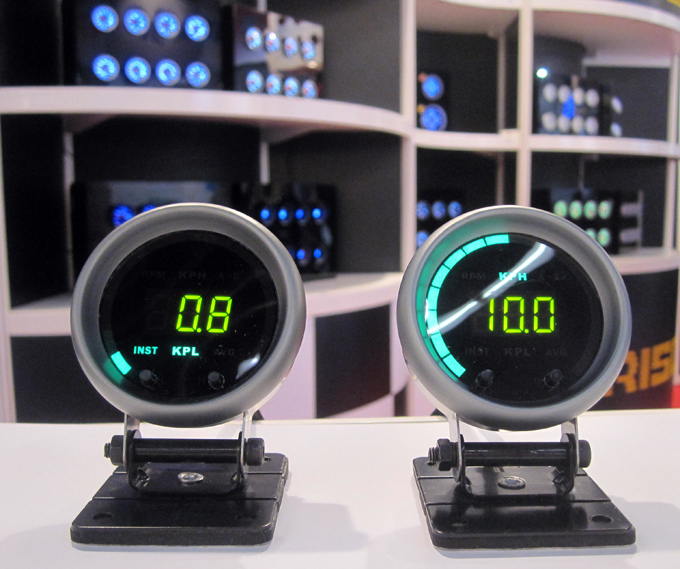
Grace Kuan, sales department manager, points that the On-Board Diagnostic (OBD) systems are in most cars and light trucks on the road today. During the1970s and early 1980's carmakers started using electronic means to control engine functions and diagnose engine problems, primarily to meet Environmental Protection Administration (EPA) emission standards. But OBD systems have become more sophisticated, with OBD-II, a new standard introduced in the mid-1990s, providing almost complete engine-control and monitoring of parts of the chassis, body and accessories, as well as the diagnostic control of a car.
Simply connecting the fancy gauge to a car's OBD II connector enables a driver to get all needed information as speed, RPM, water temperature, air temperature, advance timing angle, fuel consumption, average fuel consumption etc.
A more practical purpose to install the gauge is for better fuel efficiency. The gauge is color coded, so a driver only has to stay in the green section to achieve the best economy.
Kuan claims that the OBD II gauge saves the cost of adding various kinds of sensors or chips to collect vehicular data, and OBD II gathers very precise data as well as being easy to install.
Forged Wheels
Alex Global Aerospace Technology Inc. (AGAT) stood out as a prime example of strong motivation and ambition, a Taiwanese company that is emerging as a significant player in the global forged-wheel market due to its integrated capability, from upstream material supply to downstream manufacturing and processing.
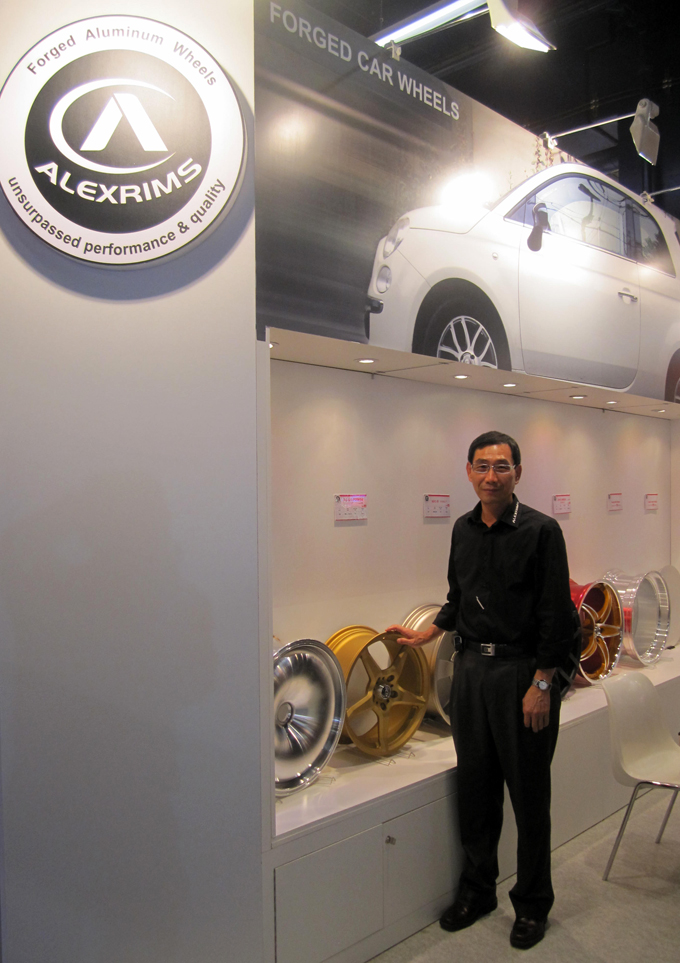
AGAT is not, strictly speaking, a newcomer in aluminum wheel making. Its parent Alex Global Technology is already the world's largest maker of aluminum-alloy bicycle wheels. Having begun planning its new production line in 2002 after extensive evaluations and close collaboration with industry experts, research institutes, and academia, AGAT has invested about NT$3 billion (US$90.9 million) to set up Taiwan's first integrated cold-forging production line, including furnace, aluminum extruder, and CNC machining centers.
According to Alex Chen, president of AGAT, his company spent three years building Taiwan's first aluminum extrusion plant to ensure a stable supply of high-quality ingots. The aluminum furnace was completed in early 2007, and trial production of forged truck wheels began in the first half of that year. After restless effort in the past few years, the firm has developed a wide range of 16- to 24-inch forged truck and bus wheels, as well as begun mass production of two- and three-piece forged wheels for passenger cars, says Chen.
AGAT's forged wheels are not only of excellent quality but also feature superior styling and craftsmanship. “Our core competitiveness rests with having fully-in-house forging, heat treating, computer numeric control (CNC)-processing,” Chen claims.
“The global forged-wheel market is still under-developed and makers try to survive with low-margin pricing. But I am sure that forged wheels will sooner or later be very popular due to being stronger, more durable, and lighter, says Chen, adding that AGAT's future sales of forged wheels look bright for most players can't afford to cross the high thresholds of technical capability and investment, while the market has been gradually expanding.
China has massive potential for forged truck wheels, Chen says. AGAT also showcased an 18-inch racing car wheel weighing only six kgs. The company plans to soon tap the original equipment (OE) market by supplying top-end forged wheels to international auto, powered two-wheeler (PTW) and truck makers.
Small-pitch Condensers
Another Taiwan-based global leader at Automechanika was Man Zai Industrial Co., Ltd., the world's largest and most-comprehensive maker of AM automotive condensers and radiators, which showcased a new model integrated with both a condenser and an oil cooler.
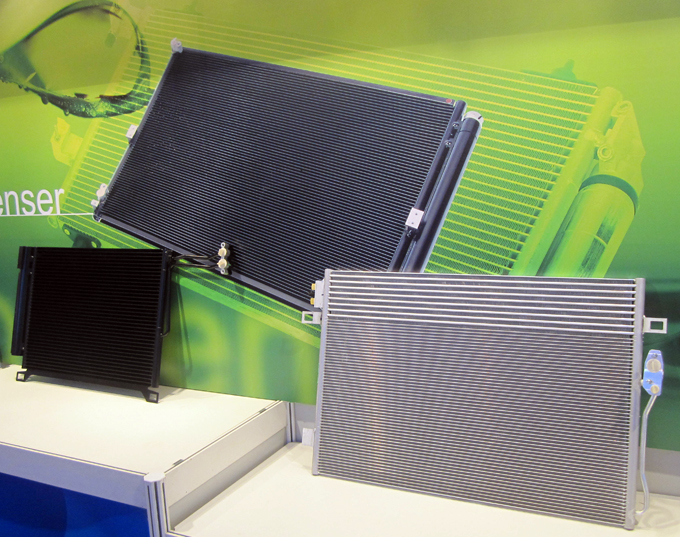
In 2006, Man Zai was the first company globally to introduce a small-pitch (6.7mm, 5.6mm for fin and 1.2mm for water tube) AM condenser, and continued in 2009 to introduce small-pitch AM radiators.
Grace Chiang, the sales manager, says that the company has been also working on full-aluminum condenser/radiator production, the most advanced technology for making condensers and radiators, adding that such production processes are very complicated while the tooling and overall production cost are relatively high compared to those for engineering-plastic tank and aluminum core models. However less energy is used to produce full-aluminum models, so they are more environmentally friendly than conventional counterparts, not to mention also being recyclable.
Man Zai is working on the full-aluminum condensers and radiators, which now are produced by big first-tier OE suppliers such as Valeo and Behr Hella. The company doesn't have a confirmed date to launch such products because sales in the AM market is still limited, according to Chiang.
Chiang attributes the company's leading status to its R&D efforts, know-how in advanced manufacturing techniques; while the company also has well-established global sales channels to effectively promote new and improved products.
In addition, she stresses, Man Zai has comprehensive testing and inspection equipment to make sure the condensers/radiators fully meet OE standards.
King of Cooling Fans
King Shing Automobile Parts Co., Ltd. is the largest maker of AM automotive cooling fans in Taiwan, as well as the world's most comprehensive supplier of such products by supplying over 1,800 cooling-fan models. The company's ambitious investment, about NT$120 million (US$3.9 million), in product development adds another 100 models to the line each year. The company operates two factories, one in Taiwan and another in Thailand.
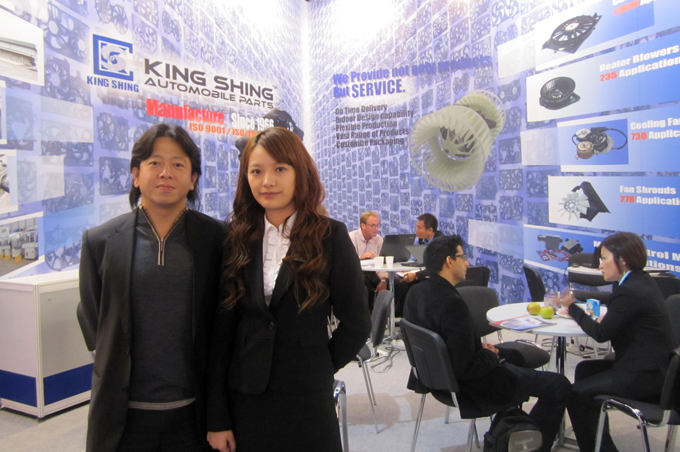
Company vice president Sim Lee says that as of the third quarter of 2010, King Shing supplies 1,830 cooling-fan models, 235 heater blower models, 730 cooling-fan motor models, and 278 fan shroud models.
“To stay globally competitive, we never stop investing in new-product development. Also we build our core advantage on service and more-advanced technical concept. We always deliver on-time, fully design in-house, have flexible production and customized packaging, as well as offering in-demand products to AM customers. Plus we can totally develop and produce the fan motors in-house,” says Lee.
Clarifying its definite strategy for the next few years, Lee says that branding always takes a long time and intensive investment, which will raise cost and, in many cases, also the cost to negotiate with global customers. “Another reason we don't promote our own brand is we're not as big as major international brands, so we are still adding to our product line.”
The company's success also lies in its smart global deployment. In Thailand, King Shing focuses on supplying products to automakers in the so-called “Eastern Detroit” as OEM. Its Taiwanese factory concentrates on making products for the AM channels, with most of the company's AM cooling fans sold to the U.S. and Europe.
Brand-New 1969 Mustang
Muscle Car GT, a supplier of auto parts and moulds, in Taiwan showed its marketing savvy at the event, displaying parts for a 1960s American pony car. Taiwan is already the world's most important supply base of AM body parts, but a new business model is forming among local players, who are leveraging the small-batch, large-variety order-filling capacity as well as the comprehensive supply chain on the island to tap the vintage replica niche.
From the hood, door frame, whole car body to steering column, every part on a 1969 Ford Mustang can be ordered, says Howard Lin, the sales manager. Working with 13 mutually-invested satellite plants enables Lin to claim that Muscle Car GT is the only integrated body-parts maker in Taiwan.
Li-ion Battery
JAS International Inc. exhibited an eco-friendly, rechargeable and smart automotive battery, the JAS High-power Automotive Battery, which has on typical cars four sets of LiFePO4 lithium-ion cells and a built-in, state-of-the-art battery management system (BMS).
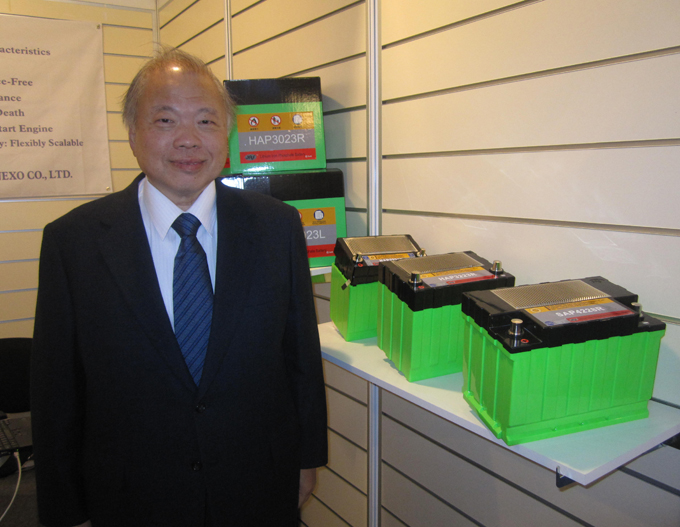
According to Arthur Su, the CEO, the BMS constantly monitors both battery and vehicle status to guard against battery depletion or failure. The Smart Battery Display on the battery alerts with light and sound in case of battery or vehicle charging malfunctions. When the battery capacity drops to 15% or lower due to battery/vehicle recharging problems, leaving the headlights on overnight, electric leakage etc., the BMS' Low Battery Protection function kicks in to automatically shut off the battery after the ignition is turned off. Then, the car can be jump-started with a single press of the RESET button without assistance.
The lithium-ion battery also provides higher energy output than conventional lead-acid counterparts and can also improve power: the engine becomes more powerful but quieter, accelerates better, has higher torque. In addition, the lights are brighter, air-conditioner performs better, and car stereo works better due to lower interference from other automotive electronics. The lithium-ion battery also improves fuel economy by 10% to 25% and emissions, Su claims.
The eco-friendliness of the battery is achieved with its three-fold cycle life, with the battery also being maintenance-free and safe. Besides heavy and intensive capital investment and long-term R&D, the JAS battery has undergone countless field tests and numerous modifications to become the premium, high-efficiency product today, says Su.




